|
IUPAT, like many modern labor unions, was founded in the 19th century to set standards for uniform compensation in the trades and provide a community for workers to share ideas and solve problems. The Brotherhood of Painters and Decorators of America was organized formally in 1887. Within a year, the union boasted a membership of over 7,000 tradesmen and more than 100 local unions. These trade unionists soon realized the power that they had together, rather than staying separate and facing their problems alone. Backed by a growing centralized union, these dedicated organizers won victories over oppressive working conditions that were once thought unchangeable. Today, the IUPAT continues to do its part to lift working families and the rest of the middle class by marching to the words of our founders :
“Single-handed we can accomplish nothing; but united there is no power of wrong we may not openly defy.”
510 Historical Highlights
Organization of our Local 510 Union began in the winter of 1899-1900 when tradesman Peter J. Doyle became "greatly perturbed" over issues such as non-standard hours, shops working 9 or 10 hours days without formal overtime, and low wages which averaged $3.00 per day for sign painters, and $2.00 for helpers on a six day week basis. Doyle gathered "a dozen or so men who were willing to form a union and applied for a charter" which was granted March 10, 1900 by the Brotherhood of Painters, Decorators and Paperhangers of America.
Upon arrival of the Charter, the first formal meeting was held in a rented hall on City Hall Avenue, San Francisco, March 27, 1900. The obligation was given and temporary officers were appointed. It was known as Brotherhood of Painters, Decorators and Paperhangers of America, Local 132. (When first chartered, the parent Brotherhood was having difficulty with an Eastern faction which had seceded. That group later asked to rejoin on condition that their old charter numbers be returned, so the original charter was returned and Local Union Charter 510 was given in its place.)
1900, Tuesday, April 10: this marked the third meeting which set about to enforce the 8 hour day, and set a minimum wage for the various classes of painters and helpers. These proposals were all accepted by employers. The union continued to add members during 1900 to close with 54 members in good standing their first year.
Some further highlights of the early years of Local 510 :
- 1902, March: the Union doubled dues and initiation fees, and a new higher scale of wages went into effect.
- 1902, March 10: Local Union 510 "had the distinction of being the first union in the Brotherhood to initiate a woman--Miss May Longest, a sign and pictorial artist who later opened a studio in San Jose."
- 1903: moved to Building Trades Temple, 927 Mission Street, San Francisco.
- 1904 saw the rise of the Citizens' Alliance which launched an open shop campaign, with no lasting success.
- 1906: the earthquake and fire managed to injure only one member. All the records of Local Union 510 remained intact except the books of 1900-1901 and the union seal.
- 1910: J.M. Mahaffey unsuccessfully attempted to have Local 510 secede from the Brotherhood (as they had in Los Angeles and Salt Lake City) to join his Sign and Pictorial Painters of America.
- 1915 proved a good year for Local Union 510 as many painters came from around the country to work in San Francisco during the Fair.
- 1930: the seven hour day was instituted with wages of $12.00 per day.
- 1932: during the depression, a wage reduction of 10% was instituted. Several months later wages were lowered an additional 15%, provoking a 14 week long strike in 1933. Local 510's first.
- 1939: The scenic Artists of Northern California & Nevada (formerly Local 621) affiliated with Local 510. Show Card Writers and Displaymen, Local 319 were also absorbed into the membership of Local 510 the same year.
- Since World War II, "notable changes" have occurred under the guidance of Richard Wendelt, Business Representative for Local 510 .
The formal training received by union members was regarded as being of high quality and gave Union membership an increased value as it also implied card carriers were skilled, thoroughly trained craftspeople.
 |
December 1899: 7th Biennial Convention of the Brotherhood of Painters and Decorators of America. |
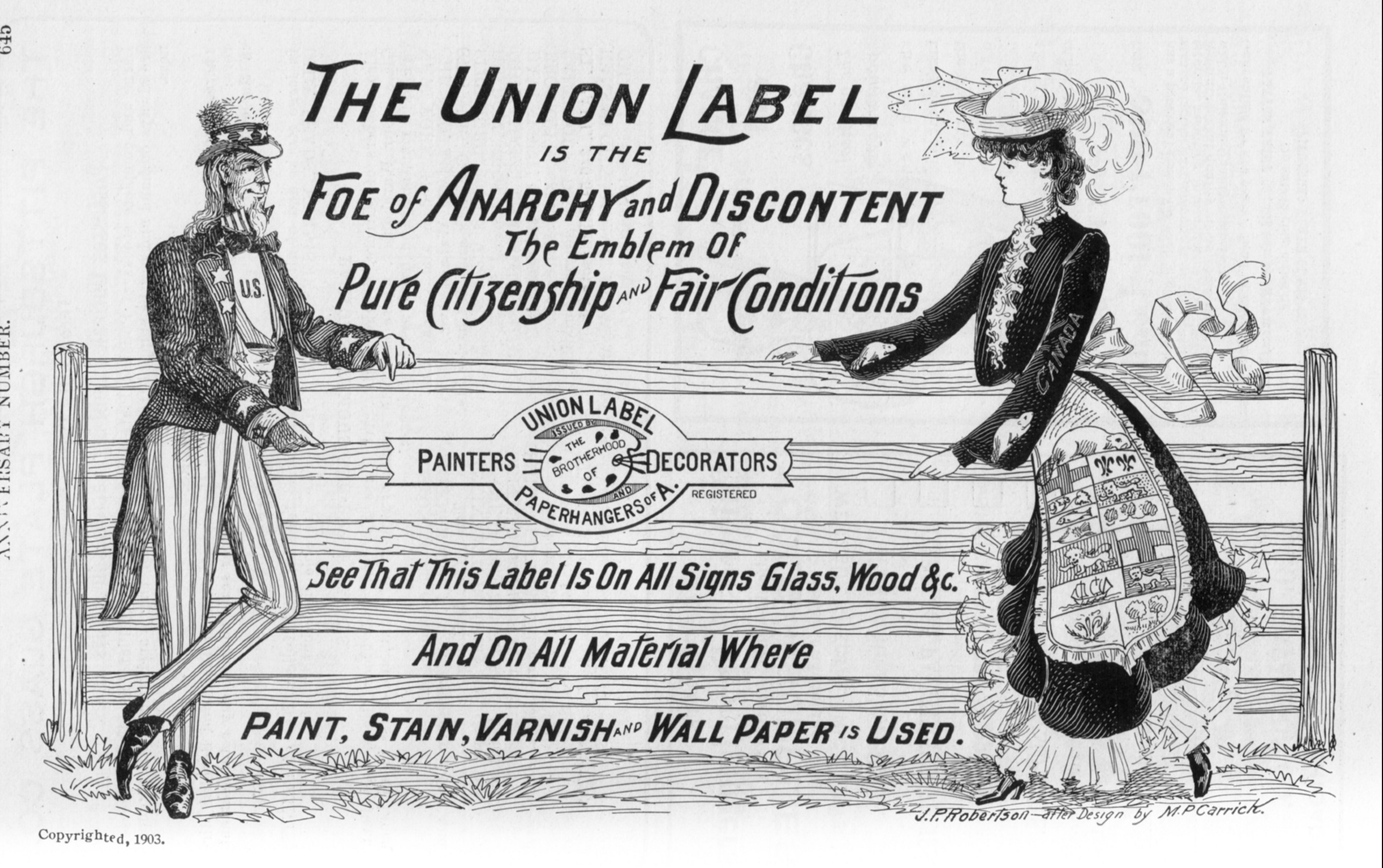 |
This union label ad was printed in the 1903 anniversary edition of The Painter and Decorator. The union label is, has, and will continue to be printed on everything this union prints, including our business cards, Constitution, and even the Journal (check the bottom of the table of contents page of the latest issue). We are proud union members, and we have the label to prove it. |
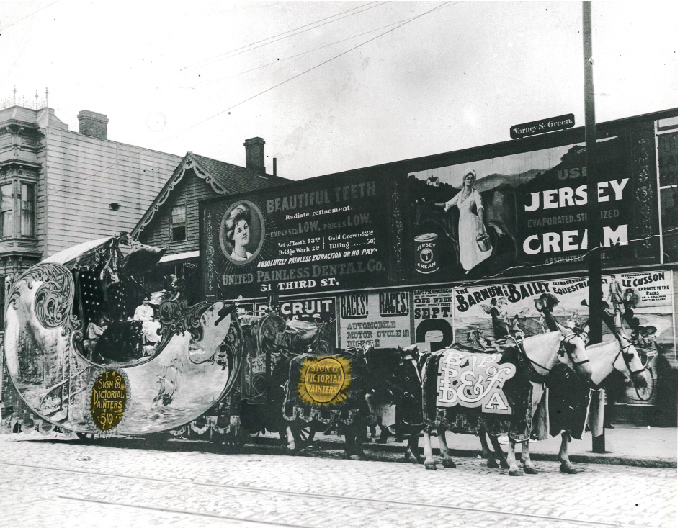 |
Local 510 on a horse-drawn float in the early 20th century. |
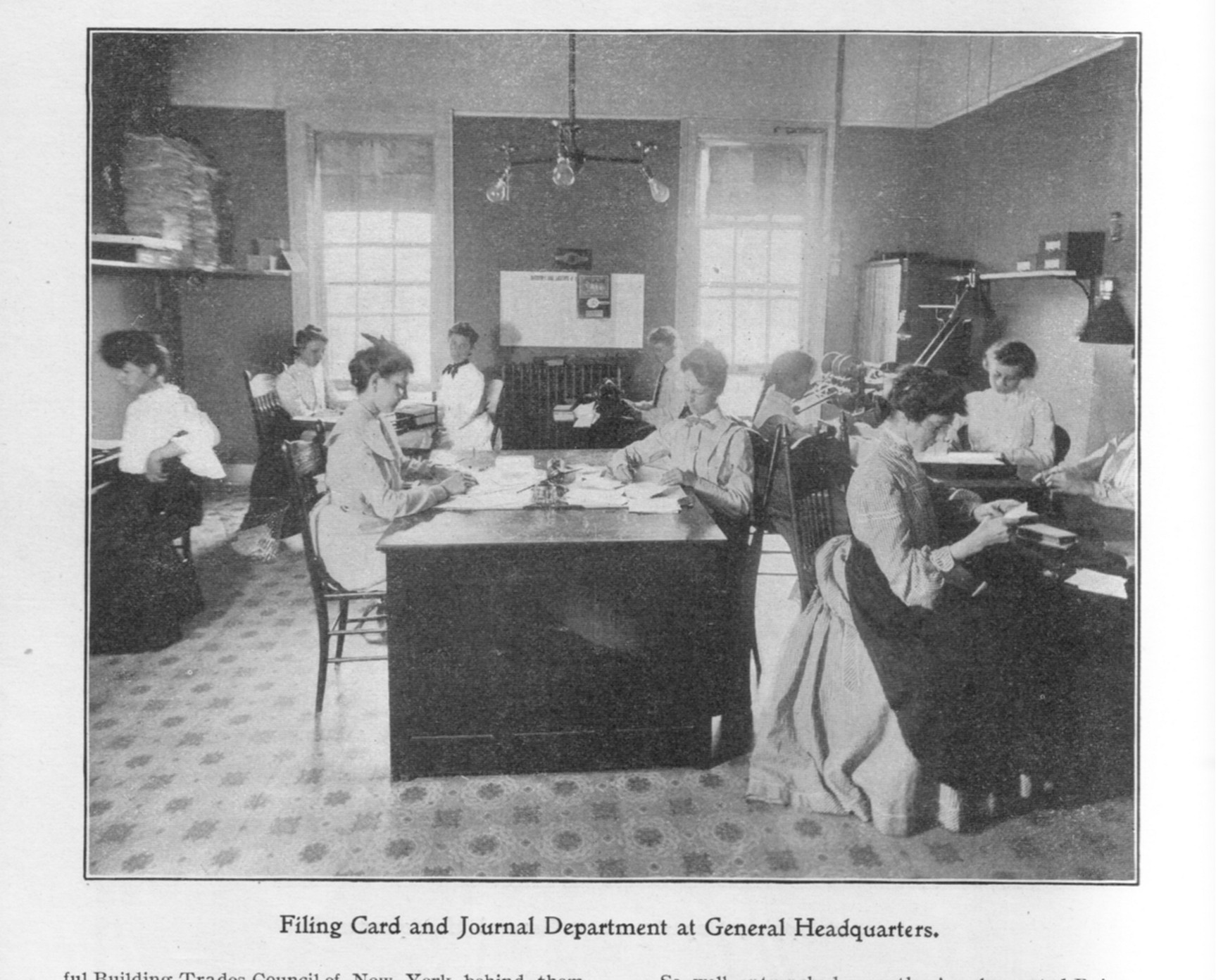 |
Filing Card and Journal Department of the Brotherhood headquarters in Lafayette, Indiana, circa September 1903. |
 |
In the early 20th century, it was common for ads like these to be painted on the sides of buildings. To the left, you can see part of a Firestone ad, while the ad in the front appears to be for the Chicago World’s Fair, aka ‘The Fair’, circa 1933.
The ads are painted on the side of the Thomas Cusack Company building. Cusack, a longtime outdoor sign painter who was dubbed the “Billboard Baron,” was known for his fair labor practices and amicable relationships with his employees.
Source: Wikipedia
|
|

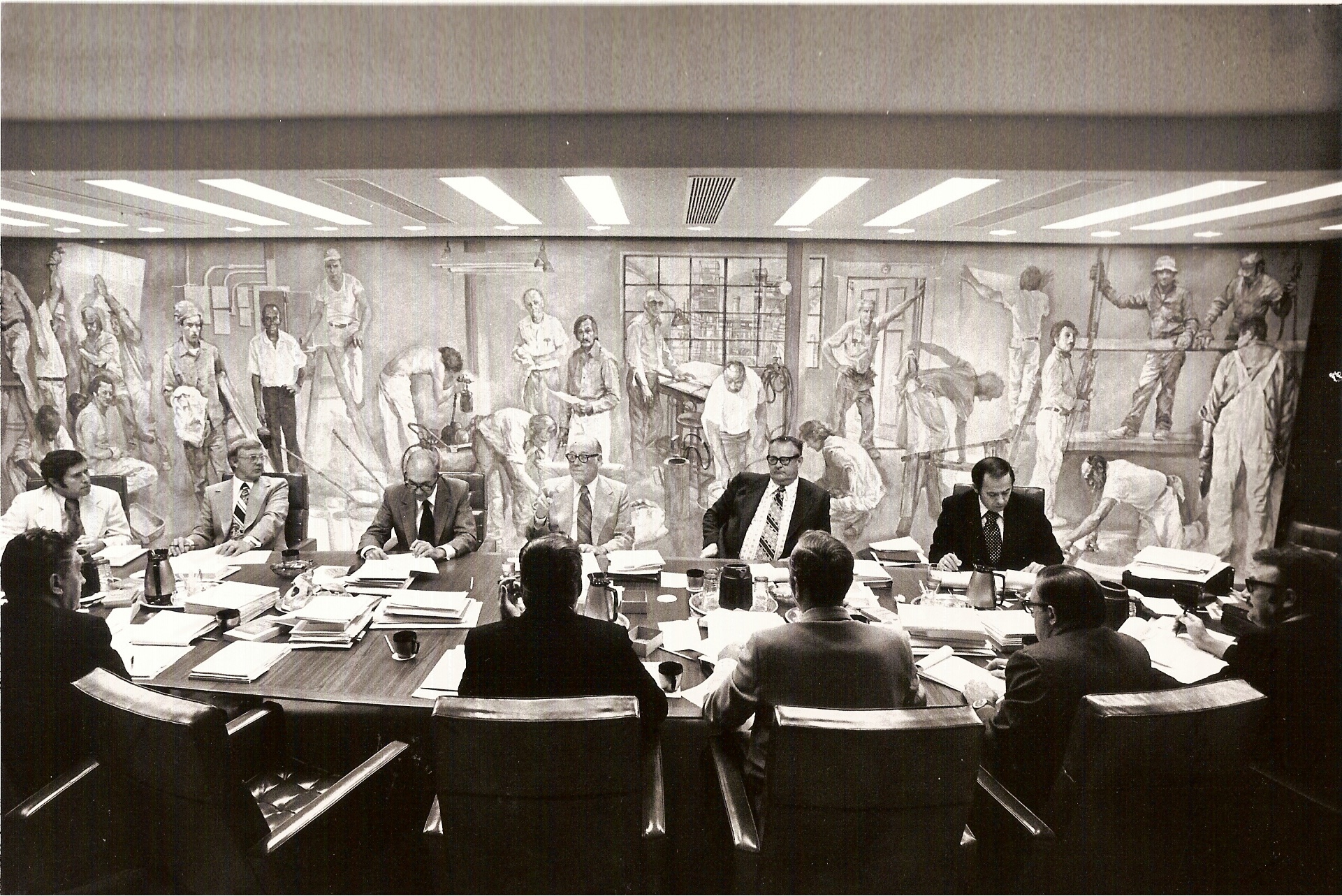
|
Herb Steinberg’s 8’6” by 30’ mural, “Painters and Allied Trades,” hung in the boardroom at the Brotherhood headquarters. |
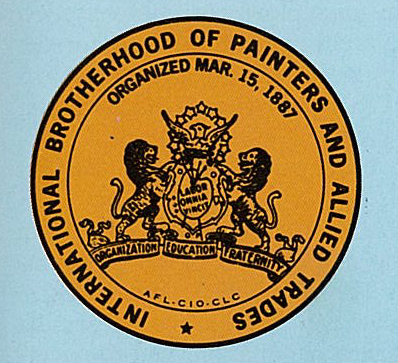 |
January, 1970: A new name and logo for a new year.
In the late 60s, a number of important unions were known by initials, most notably the UAW. General President S. Frank “Bud” Raftery hoped that his union could assume a similar mantle, perhaps “P-A-T,” for painters and allied trades. There were more than cosmetic reasons for this. The autonomous trades were becoming increasingly important and seeking recognition of the fact. The painters would stay at the forefront, but Raftery hoped that the “allied trades” would be a more dynamic and democratic umbrella for the rest.142 Although Raftery had already settled upon the acronym, a competition was held prior to the 1969 Convention. Out of 1,800 contestants, a New Orleans member was the first to propose the favored name, and as of January 1970 the “Brotherhood” became the “International Brotherhood of Painters and Allied Trades,” or “IBPAT.”
Source: One Union: The History of the International Union of Painters and Allied Trades, 1887 – 2003
|
 |
A sign and pictorial painter illustrates his craft in the early 70s. |
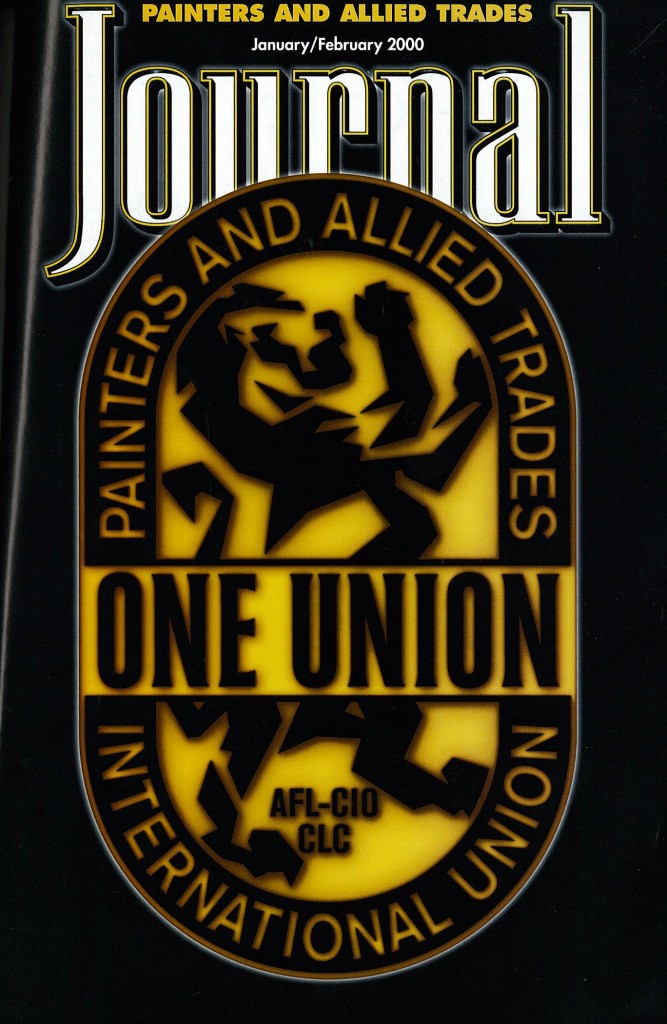 |
In the interest of the IBPAT’s growing female membership, General President Michael Monroe announced a new name at the 1999 general convention: The International *Union* of Painters and Allied Trades (IUPAT). The January/February 2000 issue of the Painters and Allied Trades Journal featured the new name and logo. |
|
|
|
|
|
|
|
|
|
|
|
|
|
|
|
|
|
|
|
|
|
|
|